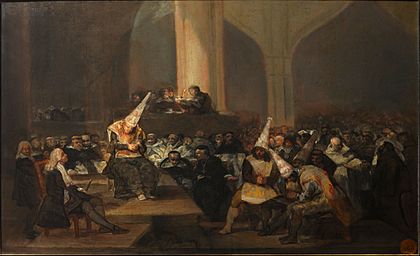The Inquisition Tribunal facts for kids
Quick facts for kids The Inquisition Tribunal |
|
|---|---|
| Spanish: Auto de fe de la Inquisición | |
 |
|
| Artist | Francisco Goya |
| Year | 1812–1819 |
| Medium | Oil on panel |
| Dimensions | 46 cm × 73 cm (18 in × 29 in) |
| Location | Real Academia de Bellas Artes de San Fernando, Madrid |
The Inquisition Tribunal, also known as The Court of the Inquisition or The Inquisition Scene, is a painting by the Spanish artist Francisco Goya. He created this oil painting between 1812 and 1819. It measures about 46 by 73 centimeters (18 by 29 inches).
This painting is part of a group of artworks by Goya. Other paintings in this series include Bullfight, The Madhouse, and A Procession of Flagellants. These paintings show old traditions that Goya and other liberal thinkers wanted to change. However, the king at the time, Ferdinand VII of Spain, did not support these reforms.
The painting was once owned by Manuel García de la Prada. Today, you can see it at the Real Academia de Bellas Artes de San Fernando in Madrid, Spain.
Contents
What the Painting Shows
This painting shows an auto-da-fé (pronounced: auto-da-fay). This was a public event held by the Spanish Inquisition inside a church. The Spanish Inquisition was a powerful court that judged people accused of not following Catholic rules.
In the painting, you can see officials, mostly monks, and one judge. Four people who are accused wear tall, pointed hats called coroza or capirote. They also wear special clothes called sanbenitos that describe their supposed crimes. Around them are many religious leaders and other important people watching the event.
The people in the front of the painting are clearly lit and detailed. But the background is dark and filled with a large, unclear crowd. This makes the church feel small and a bit scary, like a Gothic building.
About the Artist: Francisco Goya
Francisco Goya was born in 1746. He moved to Madrid in 1775 from his hometown of Zaragoza. He started his career painting designs for royal tapestries. His talent was noticed by the Spanish royal family. In 1789, he became the official court painter.
Long before he painted The Inquisition Tribunal, Goya created a portrait of a young boy in 1783. This boy, Don Manuel Osorio Manrique de Zúñiga, later became a cardinal. He eventually helped to end the Spanish Inquisition.
By the time Goya painted The Inquisition Tribunal, his art style had changed a lot. He no longer painted light and cheerful scenes like those in the rococo style. In 1792, Goya became very ill and lost his hearing permanently. This event deeply affected his art. He began to paint powerful scenes that showed human suffering and cruelty.
The Inquisition Tribunal is one of these paintings. It shows a moment of harshness. The pointed hats worn by the accused people symbolize the threat of being burned at the stake. Another painting in this series, A Procession of Flagellants, also shows cruelty. It uses symbolism, like blood on white clothes, to make its point.
The Spanish Inquisition
The Spanish Inquisition was set up in 1478. Its goal was to make sure everyone in Spain followed the rules of the Catholic Church. The first auto-da-fé happened in Seville in 1481. During this event, six conversos (Jewish people who were forced to become Christians) were burned at the stake.
Goya lived at a time when the Church had a very strong influence in Spain. He knew a lot about the history of the Inquisition. Even though its power was decreasing, it was not officially ended until 1834. Goya made many drawings, paintings, and prints that showed the cruelty of the Spanish Inquisition. He also captured the difficult and warring times he lived in.
Goya himself was called before the Inquisition twice. The first time was in 1799, because of his series of prints called Los Caprichos. He was called again in 1815. This was after his paintings The Naked Maja and The Clothed Maja were found. Luckily, he avoided serious punishment both times.
The Auto-da-fé Event
The auto-da-fé, like the one in The Inquisition Tribunal, was used to publicly shame people. It was meant to break the spirit of someone accused of being a heretic (someone who did not follow Church teachings). Often, the victims had been treated harshly before the public event until they confessed to the crimes. The people who accused them and the witnesses against them were kept secret from the accused until the public shaming.
The clothes the accused had to wear during the auto-da-fé often showed their crime and punishment. Victims wore a coroza, which was a tall, cone-shaped hat. If someone was going to be burned at the stake, their sleeveless vest, called a sambenito, had flames painted on it against a black background. These clothes often also had the victim’s name, social status, supposed crime, and the date of their conviction written on them.
See also
 In Spanish: Auto de fe de la Inquisición (Goya) para niños
In Spanish: Auto de fe de la Inquisición (Goya) para niños
- List of works by Francisco Goya

